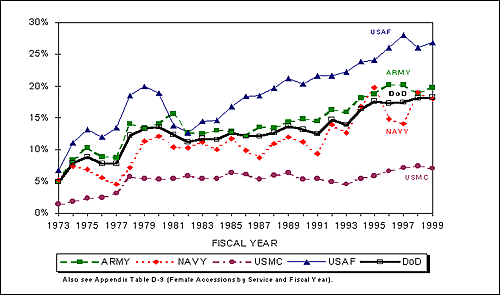
Gender
|
|||||||||||||||||||||||||||||
Figure 2.3 illustrates the trend in the proportion of female recruits since the start of the All Volunteer Force.Appendix Table D-9 shows the number and proportion of NPS female accessions by Service in FY 1964 and FYs 1970 through 1999.The Air Force traditionally has the largest proportion of women recruits and the Marine Corps the smallest, in part a result of the number of positions open to women in these Services.
The proportion of NPS women accessing into the Services, 18 percent in FY 1999, is not comparable to female representation in the civilian population (50 percent).One reason for the difference is the lower inclination of women than men to apply for and enter the military. [1] With policy changes concerning women in combat, [2] more women may enter the Services and retention may increase among female members.The gender-integration policy has been in effect for five years—FY 1995 was the first year under the new rules—and during this time there has been a continued gradual increase in the number and percentage of women enlisting in the Services. [3]
 Figure 2.3.Women as a percentage of Active Component NPS accessions,
FYs 1973–1999.
Figure 2.3.Women as a percentage of Active Component NPS accessions,
FYs 1973–1999.
Under a gender-neutral recruiting program since FY 1990, the Air Force leads the Services in the proportion of female accessions.The Air Force has increased its proportion of female recruits, from 20 percent in FY 1990 to 27 percent in FY 1999, a slight increase from 26 percent in FY 1998, but not reaching the record-breaking 28 percent of FY 1997 (see Table D-9). When the Navy adopted a gender-neutral recruiting policy in FY 1994, the proportion of women accessions in the Navy increased 3 percentage points (from 17 percent in FY 1994 to 20 percent in FY 1995).However, the Navy dropped its gender-neutral recruiting policy because of the constrained berthing facilities on Navy vessels. The Navy’s decision to rescind gender-neutral recruiting may be a factor in the 6-percentage-point drop of female accessions from FY 1995 to FY 1997 (from 20 to 14 percent). [4] However, the Navy was able to recruit a significantly larger proportion of women in FYs 1998 and 1999 (19 and 18 percent, respectively).
[1] The annual DoD-sponsored Youth Attitude Tracking Study indicates that young women, depending upon age, are approximately one-half less inclined to join the military than young men.
[2] Memorandum from Les Aspin, Secretary of Defense, Subject:Policy on the Assignment of Women in the Armed Forces, April 28, 1993; Memorandum from Les Aspin, Secretary of Defense, Subject:Direct Ground Combat Definition and Assignment Rule, January 13, 1994.
[4] Born, D.H., Women in the Military-Trends 1990 to 1996 (Washington, DC: Office of the Assistant Secretary of Defense [Force Management Policy/Accession Policy]).